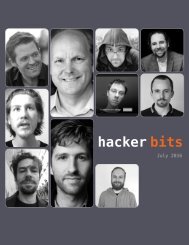Hacker Bits, Issue 12
HACKER BITS is the monthly magazine that gives you the hottest technology stories crowdsourced by the readers of Hacker News. We select from the top voted stories and publish them in an easy-to-read magazine format. Get HACKER BITS delivered to your inbox every month! For more, visit https://hackerbits.com/issue12.
HACKER BITS is the monthly magazine that gives you the hottest technology stories crowdsourced by the readers of Hacker News. We select from the top voted stories and publish them in an easy-to-read magazine format.
Get HACKER BITS delivered to your inbox every month! For more, visit https://hackerbits.com/issue12.
You also want an ePaper? Increase the reach of your titles
YUMPU automatically turns print PDFs into web optimized ePapers that Google loves.
I have 6 rules when giving this interview method<br />
RULE #1 — Give them the weekend to solve the problem.<br />
This is where I and Eric slightly disagree. 2 hours just isn’t enough time to see how well someone can<br />
come up with an appropriate solution.<br />
What I like to do is invite them to the office on a Friday and go over the problem at hand and how I<br />
would like for them to solve it. Then I’ll hand it off to them and set up time on Monday to review their<br />
solution.<br />
I’ll provide them with certain technologies that should be used for the solution and let them use other<br />
tools or technologies at their discretion. For example, I may say “please use functional reactive principles<br />
in JS to solve this problem”, but the decision of using Kefir, Bacon, or RX is left up to them.<br />
RULE #2 — DON’T use a real problem because of the tribal knowledge needed to fix.<br />
This goes hand in hand with Rule #1, but unless you’re hiring a customer service rep, it’s almost impossible<br />
to hand someone a computer and say OK, Fix this issue happening in our proprietary system<br />
using the tools that normally everyone gets properly trained on.<br />
Give them a problem that is very self-contained.<br />
RULE #3 — The solution you’re expecting should be clear, but open for improvement.<br />
For example, if I’m interviewing a web developer, I’ll give him a sample clear scenario:<br />
Create a single page app that lets me enter movies in my home movie collection, store them in offline<br />
storage and search through them. I want to search by Genre, Title & Actors.<br />
I actually don’t give them further directions like use web storage vs cookies, or make it responsive on<br />
multiple platforms and use a custom stylesheet. I leave that up to them.<br />
Some choose to do what we asked, and some do much more.<br />
In the end, what matters is that we like the end result.<br />
I don’t say “I like movies, create me a nice movie website”, or “How would you architect IMDB if you had<br />
to create it from scratch.” I want the task to be simple enough that the engineer can provide a solution<br />
and challenging enough so they can use their skills to create something special.<br />
RULE #4 — Let them present their solution to a group on Monday.<br />
The biggest issue I have seen with tech hires is that they can become very defensive over their solution.<br />
I will purposely (respectfully) challenge their solution to see how they react.<br />
If they get defensive, it’s an immediate no-go. Remember, there’s a difference between defending<br />
which is good and being defensive which is bad. The difference is that the former is based on rational<br />
facts, the other is based on emotion.<br />
A key aspect of this is that everyone in the group MUST come prepared, having looked through the<br />
solution.<br />
RULE #5 — Write the problem down for them to take home.<br />
Be clear about what technologies, tools and look you’re after, and the standards being judged. At the<br />
same time, leave the final solution open enough that the candidate can add their own flair. Let them<br />
hacker bits<br />
27















